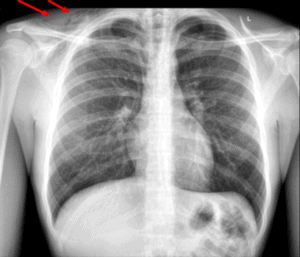Published on
Differential Diagnosis
- Acute coronary syndrome
- Boerhaave syndrome
- Pneumomediastinum
- Pneumothorax
- Pulmonary embolism

Diagnosis
Subcutaneous foci of air are noted in the right supraclavicular region. Air is seen tracking along the paratracheal regions and the mediastinum.
This patient was diagnosed with pneumomediastinum and subcutaneous emphysema.
Learnings/What to Look for
- Pneumomediastinum is the presence of extraluminal gas within the mediastinum. Gas may originate from the lungs, trachea, central bronchi, esophagus, and peritoneal cavity and track from the mediastinum to the neck or abdomen
- Causes include chest trauma, neck, thoracic, or retroperitoneal surgery, esophageal perforation, tracheobronchial perforation, vigorous exercise (childbirth, weightlifting, Valsalva), asthma, barotrauma, infection (tuberculosis, histoplasmosis, dental, or retropharyngeal infection, mediastinitis), interstitial lung disease, connective tissue disorders, interstitial lung disease, or may be idiopathic
- Rarely, tension pneumomediastinum may occur due to elevated mediastinal pressure which leads to diminished cardiac output from direct cardiac compression or reduced venous return
- When extensive subcutaneous and mediastinal gas is present, airway compression may also occur
Pearls for Urgent Care Management and Considerations for Transfer
- Patients with new onset pneumomediastinum should be transferred for evaluation of the etiology and management
- If there is respiratory distress place oxygen and an IV while awaiting transport
Acknowledgment: Images and case provided by Experity Teleradiology (www.experityhealth.com/teleradiology).
An 18-Year-Old Male with Shortness of Breath and ‘Tightness’ in His Chest
1 2
